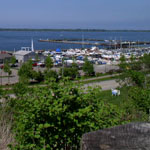 A Slow Start
A Slow Start
After the American Revolution (1775–1783), the newly formed state of Pennsylvania looked forward to expanding settlement of its western lands. The territory known as the “Erie Triangle,” the northern-most piece of Pennsylvania today, offered access to the Great Lakes and a safe harbor, a temperate climate, fertile soil, and an abundance of fresh water (creeks and streams). Settlement of the Erie Triangle was delayed, however, because the states of New York, Massachusetts and Connecticut all claimed this western land. The land (Erie Triangle) was ceded to the federal government during the 1780s as a result of territorial compromises made by each of the states with the federal government. In 1792, the state of Pennsylvania purchased the Erie Triangle from the federal government for 75¢ per acre…the total came to $151,640.25.
Actual settlement of the Erie Triangle began but with tremendous conflict. The Six Nations of the Iroquois Confederacy (Seneca, Mohawk, Onieda, Onondaga, Cayuga, and Tuscarora) claimed ownership of the Erie Triangle even after the state of Pennsylvania purchased the land. Settlement was made possible because, a year earlier, General “Mad” Anthony Wayne defeated the Western Indian tribes. The Six Nations could not win the battle for the Erie Triangle without their western neighbors. Therefore, unable to defend the Triangle any longer, the Six Nations signed a peace treaty in Canandaigua, New York with the United States of America giving up ownership of the Erie Triangle.
A Town at Presque Isle
Once the treaty was signed, a surveying party was sent to the Triangle. In the summer of 1795, Andrew Ellicott and General William Irvine surveyed lands of the Erie Triangle, and located and layed out the towns of Erie and Waterford. That same year, Erie’s first family of settlers arrived. Camped along the bayfront, another man hired to continue surveying the land, Deputy Surveyor Thomas Rees, and a few of his men spotted a campfire on Presque Isle. Fearing Indians had moved onto the peninsula, Rees and a few armed men took canoes across the bay at dawn to explore the mysterious fire. They found Colonel Seth Reed, his wife, and his two sons. The Reed family, also fearing an Indian attack, explained to Rees and his party that they had been too afraid to settle along the shore and had felt safer on the peninsula. Rees brought the Reed family back to shore, where they built the first house in Erie. It was made of logs and stones from the creek bed, and was located at the mouth of Millcreek.
Drawn by Erie’s fertile soil, freshwater streams and hardwood forests, settlers from the east (New York and New England) moved to the “Town at Presque Isle.” Erie County was named, and its boundaries set on March 12, 1800. The first section of the town of Erie was incorporated as a borough in July 1805. It was one square mile. Erie became a city in 1851.

One Response to Settlement of the Erie Triangle